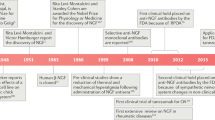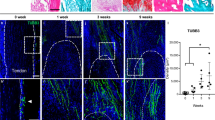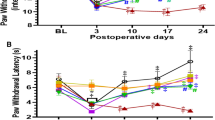Abstract
Chemotherapy-induced peripheral neuropathy (CIPN) is one of the pervasive side effects of chemotherapy, leading to poor quality of life in cancer patients. Discovery of powerful analgesics for CIPN is an urgent and substantial clinical need. Nerve growth factor (NGF), a classic neurotrophic factor, has been identified as a potential therapeutic target for pain. In this study, we generated a humanized NGF monoclonal antibody (DS002) that most effectively blocked the interaction between NGF and tropomyosin receptor kinase A (TrkA). We showed that DS002 blocked NGF binding to TrkA in a dose-dependent manner with an IC50 value of 6.6 nM; DS002 dose-dependently inhibited the proliferation of TF-1 cells by blocking the TrkA-mediated downstream signaling pathway. Furthermore, DS002 did not display noticeable species differences in its binding and blocking abilities. In three chemotherapy-induced rat models of CIPN, subcutaneous injection of DS002 produced a significant prophylactic effect against paclitaxel-, cisplatin- and vincristine-induced peripheral neuropathy. In conclusion, we demonstrate for the first time that an NGF inhibitor effectively alleviates pain in animal models of CIPN. DS002 has the potential to treat CIPN pain in the clinic.
Similar content being viewed by others
Log in or create a free account to read this content
Gain free access to this article, as well as selected content from this journal and more on nature.com
or
References
Bae EH, Greenwald MK, Schwartz AG. Chemotherapy-induced peripheral neuropathy: mechanisms and therapeutic avenues. Neurotherapeutics. 2021;18:2384–96.
Han Y, Smith MT. Pathobiology of cancer chemotherapy-induced peripheral neuropathy (CIPN). Front Pharmacol. 2013;4:156.
Quasthoff S, Hartung HP. Chemotherapy-induced peripheral neuropathy. J Neurol. 2002;249:9–17.
Gutiérrez-Gutiérrez G, Sereno M, Miralles A, Casado-Sáenz E, Gutiérrez-Rivas E. Chemotherapy-induced peripheral neuropathy: clinical features, diagnosis, prevention and treatment strategies. Clin Transl Oncol. 2010;12:81–91.
Hu S, Huang KM, Adams EJ, Loprinzi CL, Lustberg MB. Recent developments of novel pharmacologic therapeutics for prevention of chemotherapy-induced peripheral neuropathy. Clin Cancer Res. 2019;25:6295–301.
Tonello R, Lee SH, Berta T. Monoclonal antibody targeting the matrix metalloproteinase 9 prevents and reverses paclitaxel-induced peripheral neuropathy in mice. J Pain. 2019;20:515–27.
Hirayama Y, Ishitani K, Sato Y, Iyama S, Takada K, Murase K, et al. Effect of duloxetine in Japanese patients with chemotherapy-induced peripheral neuropathy: a pilot randomized trial. Int J Clin Oncol. 2015;20:866–71.
Loprinzi CL, Lacchetti C, Bleeker J, Cavaletti G, Chauhan C, Hertz DL, et al. Prevention and management of chemotherapy-induced peripheral neuropathy in survivors of adult cancers: ASCO guideline update. J Clin Oncol. 2020;38:3325–48.
Smith EM, Pang H, Cirrincione C, Fleishman S, Paskett ED, Ahles T, et al. Effect of duloxetine on pain, function, and quality of life among patients with chemotherapy-induced painful peripheral neuropathy: a randomized clinical trial. JAMA. 2013;309:1359–67.
Levi-Montalcini R, Hamburger V. Selective growth stimulating effects of mouse sarcoma on the sensory and sympathetic nervous system of the chick embryo. J Exp Zool. 1951;116:321–61.
Levi-Montalcini R. The nerve growth factor 35 years later. Science. 1987;237:1154–62.
Lewin GR, Rueff A, Mendell LM. Peripheral and central mechanisms of NGF-induced hyperalgesia. Eur J Neurosci. 1994;6:1903–12.
Pezet S, McMahon SB. Neurotrophins: mediators and modulators of pain. Annu Rev Neurosci. 2006;29:507–38.
Bibel M, Barde YA. Neurotrophins: key regulators of cell fate and cell shape in the vertebrate nervous system. Genes Dev. 2000;14:2919–37.
Lewin GR, Barde YA. Physiology of the neurotrophins. Annu Rev Neurosci. 1996;19:289–317.
Wiesmann C, Ultsch MH, Bass SH, de Vos AM. Crystal structure of nerve growth factor in complex with the ligand-binding domain of the TrkA receptor. Nature. 1999;401:184–8.
Schnitzer TJ, Easton R, Pang S, Levinson DJ, Pixton G, Viktrup L, et al. Effect of tanezumab on joint pain, physical function, and patient global assessment of osteoarthritis among patients with osteoarthritis of the hip or knee: a randomized clinical trial. JAMA. 2019;322:37–48.
Konno SI, Nikaido T, Markman JD, Ohta M, Machida T, Isogawa N, et al. Tanezumab for chronic low back pain: a long-term, randomized, celecoxib-controlled Japanese Phase III safety study. Pain Manag. 2022;12:323–35.
Zhang B, Tian X, Qu Z, Liu J, Yang L. Relative efficacy and safety of tanezumab for osteoarthritis: a systematic review and meta-analysis of randomized-controlled trials. Clin J Pain. 2021;37:914–24.
Bramson C, Herrmann DN, Carey W, Keller D, Brown MT, West CR, et al. Exploring the role of tanezumab as a novel treatment for the relief of neuropathic pain. Pain Med. 2015;16:1163–76.
Dakin P, DiMartino SJ, Gao H, Maloney J, Kivitz AJ, Schnitzer TJ, et al. The efficacy, tolerability, and joint safety of fasinumab in osteoarthritis pain: a phase iib/iii double-blind, placebo-controlled, randomized clinical trial. Arthritis Rheumatol. 2019;71:1824–34.
Dakin P, Kivitz AJ, Gimbel JS, Skrepnik N, DiMartino SJ, Emeremni CA, et al. Efficacy and safety of fasinumab in patients with chronic low back pain: a phase II/III randomised clinical trial. Ann Rheum Dis. 2020;80:509–17.
Hefti FF, Rosenthal A, Walicke PA, Wyatt S, Vergara G, Shelton DL, et al. Novel class of pain drugs based on antagonism of NGF. Trends Pharmacol Sci. 2006;27:85–91.
Mantyh PW, Koltzenburg M, Mendell LM, Tive L, Shelton DL. Antagonism of nerve growth factor-TrkA signaling and the relief of pain. Anesthesiology. 2011;115:189–204.
Youk J, Kim YS, Lim JA, Shin DY, Koh Y, Lee ST, et al. Depletion of nerve growth factor in chemotherapy-induced peripheral neuropathy associated with hematologic malignancies. PLoS One. 2017;12:e0183491.
De Santis S, Pace A, Bove L, Cognetti F, Properzi F, Fiore M, et al. Patients treated with antitumor drugs displaying neurological deficits are characterized by a low circulating level of nerve growth factor. Clin Cancer Res. 2000;6:90–5.
Velasco R, Navarro X, Gil-Gil M, Herrando-Grabulosa M, Calls A, Bruna J. Neuropathic pain and nerve growth factor in chemotherapy-induced peripheral neuropathy: prospective clinical-pathological study. J Pain Symptom Manag. 2017;54:815–25.
Chaplan SR, Bach FW, Pogrel JW, Chung JM, Yaksh TL. Quantitative assessment of tactile allodynia in the rat paw. J Neurosci Methods. 1994;53:55–63.
Yoon C, Wook YY, Sik NH, Ho KS, Mo CJ. Behavioral signs of ongoing pain and cold allodynia in a rat model of neuropathic pain. Pain. 1994;59:369–76.
Flatters SJ, Bennett GJ. Ethosuximide reverses paclitaxel- and vincristine-induced painful peripheral neuropathy. Pain. 2004;109:150–61.
Halvorson KG, Kubota K, Sevcik MA, Lindsay TH, Sotillo JE, Ghilardi JR, et al. A blocking antibody to nerve growth factor attenuates skeletal pain induced by prostate tumor cells growing in bone. Cancer Res. 2005;65:9426–35.
Fallon M, Sopata M, Dragon E, Brown MT, Viktrup L, West CR, et al. LBA62 efficacy and safety of tanezumab in subjects with cancer pain predominantly due to bone metastasis receiving background opioid therapy. Ann Oncol. 2021;32:S1339.
Acknowledgements
This work was supported by the China National Major Scientific and Technological Special Project [2019ZX09732002-006]; the National Natural Science Foundation of China [81872785 and 81673347]; the Shanghai Municipal Commission of Science and Technology of China [17431904400, 19YF1457400 and 21S11904500]; the Institutes for Drug Discovery and Development, Chinese Academy of Sciences [CASIMM0120202007 and CASIMM0120202008]; and the Major Scientific and Technological Special Project of Zhongshan City [191022172638719 and 210205143867019].
Author information
Authors and Affiliations
Contributions
CHW, LT and YLC conceived the study and designed the experiments. ZJL, ZBX, JT, GJC, GJL, LY, KXW, HPD, HQ, QW, and GFW conducted the experiments. ZJL and CHW wrote the manuscript. All authors read and approved the final manuscript.
Corresponding author
Ethics declarations
Competing interests
Jie Tan and Yi-li Chen received stipends from Shanghai Mabstone Biotechnologies, Ltd, and Lei Tang, Gan-jun Chen, Guo-jian Liu, Lin Yuan, Kai-xin Wang, Hua-ping Ding, Zuo-bin Xie, and Chun-he Wang from Dartsbio Pharmaceuticals, Ltd. The remaining authors declare no conflicts of interest.
Supplementary information
Rights and permissions
About this article
Cite this article
Liang, Zj., Tan, J., Tang, L. et al. NGF monoclonal antibody DS002 alleviates chemotherapy-induced peripheral neuropathy in rats. Acta Pharmacol Sin 43, 2841–2847 (2022). https://doi.org/10.1038/s41401-022-00904-8
Received:
Accepted:
Published:
Issue date:
DOI: https://doi.org/10.1038/s41401-022-00904-8
Keywords
This article is cited by
-
Nerve growth factor: what can surgeons and oncologists learn from a neurological and psychological biomarker?
Molecular Medicine (2025)
-
Lentinula edodes mycelia extract abrogates chemotherapy-evoked cold and mechanical allodynia in mice
Future Journal of Pharmaceutical Sciences (2025)
-
Lidocaine—A Promising Candidate for the Treatment of Cancer-Induced Bone Pain: A Narrative Review
Advances in Therapy (2025)



